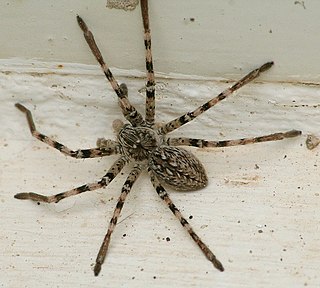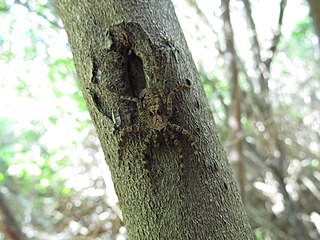
Huntsman spiders, members of the family Sparassidae, are known by this name because of their speed and mode of hunting. They also are called giant crab spiders because of their size and appearance. Larger species sometimes are referred to as wood spiders, because of their preference for woody places. In southern Africa the genus Palystes are known as rain spiders or lizard-eating spiders. Commonly they are confused with baboon spiders from the Mygalomorphae infraorder, which are not closely related.

Idiopidae, also known as armored trapdoor spiders, is a family of mygalomorph spiders first described by Eugène Simon in 1889. They have a large body similar to tarantulas.

Barychelidae, also known as brushed trapdoor spiders, is a spider family with about 300 species in 42 genera. Most spiders in this family build trapdoor burrows. For example, the 20 millimetres (0.79 in) long Sipalolasma builds its burrow in rotted wood, with a hinged trapdoor at each end. The 10 millimetres (0.39 in) long Idioctis builds its burrow approximately 5 centimetres (2.0 in) deep, just below the high tide level, sealing the opening with a thin trapdoor.

Migidae, also known as tree trapdoor spiders, is a family of spiders with about 100 species in eleven genera. They are small to large spiders with little to no hair and build burrows with a trapdoor. Some species live in tree fern stems. They have a Gondwanan distribution, found almost exclusively on the Southern Hemisphere, occurring in South America, Africa, Madagascar, Australia, New Zealand and New Caledonia.

Tarantulas comprise a group of large and often hairy spiders belonging to the family Theraphosidae. Currently, about 1,000 species have been identified. The term tarantula is usually used to describe members of the family Theraphosidae, although many other members of the same infraorder (Mygalomorphae) are commonly referred to as "tarantulas" or "false tarantulas". Some of the more common species have become popular in the exotic pet trade. New World species kept as pets have urticating hairs that can cause irritation to the skin, and in extreme cases, cause damage to the eyes.

Idiops is a genus of armored trapdoor spiders that was first described by Josef Anton Maximilian Perty in 1833.

Eusparassus is a genus of huntsman spiders that was first described by Eugène Louis Simon in 1903.

Olios is the largest genus of huntsman spiders, containing 250 species. They are found throughout the world, with most species occurring in hot countries. The genus was first described by Charles Athanase Walckenaer in 1837.
Reginald Frederick Lawrence FRSSAf was a South African arachnologist and myriapodologist at the South African Museum in Cape Town from 1922 until 1935, director of the Natal Museum in Pietermaritzburg from 1935 until 1948 and a researcher and staff member of the same museum until 1986.
Neotama is a genus of tree trunk spiders that was first described by M. Baehr & B. Baehr in 1993.
Austrophaea is a monotypic genus of African corinnid sac spiders containing the single species, Austrophaea zebra. It was first described by R. F. Lawrence in 1952, and has only been found in South Africa.
Ancylotrypa is a genus of African wafer trapdoor spiders that was first described by Eugène Simon in 1889. Originally placed with the Ctenizidae, it was moved to the Cyrtaucheniidae in 1953.
Dresserus is a genus of African velvet spiders that was first described by Eugène Simon in 1876.

Anyphops is a genus of wall spiders that was first described by P. L. G. Benoit in 1968.
Spiroctenus is a genus of spiders in the Nemesiidae family. It was first described in 1889 by Simon. As of 2017, it contains 30 species, all from South Africa.
Arandisa is a monotypic genus of Namibian huntsman spiders containing the single species, Arandisa deserticola. It was first described by R. F. Lawrence in 1938, and is found in Namibia.
Palpimanus is a genus of palp-footed spiders that was first described by L. Dufour in 1820.

Hexophthalma is a genus of spiders in the family Sicariidae. Although the genus was originally erected in 1878, it was merged into the genus Sicarius in the 1890s, and remained unused until revived in 2017, when it was discovered that the African species then placed in Sicarius were distinct. The English name six-eyed sand spiders is used for members of the genus, particularly Hexophthalma hahni. Species in the genus have necrotic (dermonecrotic) venom, and can potentially cause serious or even life-threatening wounds.
Ikuma is a genus of Namibian palp-footed spiders that was first described by R. F. Lawrence in 1938. As of June 2019 it contains only two species, found only in Namibia: I. spiculosa and I. squamata.










